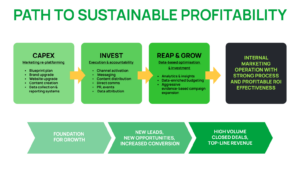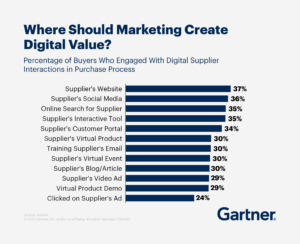General Business Strategy
Most Common Sales and Growth Challenges For Entrepreneurial Engineers: Questions & Answers!
We’ve worked with enough engineering-related firms over the last 30 years that the patterns and challenges we see have become quite familiar.
Given so many firms seem to ‘hit the wall’ for similar reasons, we wanted to unpack the problems and talk about some viable solutions.
‘STUCK’!
TYPICAL GROWTH CHALLENGES FACED BY ENGINEERING-RELATED BUSINESSES
These businesses are usually founded by an engineer who spots an entrepreneurial opportunity and/or has a particular passion and decides to give it a go.
The first few years is a big effort refining and simultaneously selling the service or product, and the business tends to grow well during this period while operational delivery capacity is also built. Staff are hired and costs rise – the ‘beast is getting hungry’.
Now let’s get something out of the way: most engineers didn’t start out as entrepreneurs, and taking a business to market wasn’t part of their skillset. So, when they start, it’s always with good old-fashioned one to one selling, and it works during the business’s infancy where passion and determination are enough to deliver growth. It’s an exciting period and leads to the understandable assumption that this model will just continue to deliver into the future.
And it’s about now that businesses often get stuck. Growth slows and the beast becomes a burden.
Why? A few reasons.
A big one is that traditional sales is an unscalable model. Personal networks are finite and have been squeezed as much as possible, salespeople can only cover so much ground, make so many calls and have so much of an impact on the market, leads slow, and maintaining growth becomes a real challenge. (This model could be called analogue and completely ignores the fact that B to B selling – and buying – has been completely revolutionised thanks to the dominance of digital).
On top of all that, the leads they do get seem to be harder to close with much longer sales cycles, thanks to slicker competitors, and the greater number of people in the buying decision.
Meantime, the business isn’t presenting itself well, isn’t clear enough about its differentiating strengths and just isn’t making an impact in the market. Without a digital presence, the business often finds it doesn’t even get onto buyers’ radar.
Despite the CEO/founder being stretched to the limit trying to manage all this, being torn between making sales and delivering the work, the only thing growing is frustration.
A REALISATION STARTS TO DAWN
Eventually, it occurs to him or her that while they’ve been busy building the business, the only part they’ve never been able to develop is marketing. Mostly because it didn’t seem to be needed, partly because it’s not something they understand. Sure, they got a website done at some stage, but it doesn’t really capture what the business is now all about.
Maybe that’s an oversight, they think, and it’s time we did something about ‘this marketing thing’ that everybody else seems to use!
They might try some DIY marketing, ask the salespeople to get on LinkedIn, ask the receptionist to post some content, maybe hire a junior to help out … but none of it works and it becomes obvious a different approach is required.
But what? Who? How? How much? How to avoid the cowboys? Where to even begin?
If all this sounds a bit like you, hang in there. While your business may be unique, the challenges you’re facing are not uncommon at all, and there are tried, tested and proven solutions that help.
Let’s start with five questions we get aaaaaaaaalllll the time by entrepreneurial engineers. And – in brief – the advice we provide.
But here’s an upfront warning: the ways these solutions are typically delivered by the marketing industry will NOT be right for a business of your size and characteristics.
“Can marketing really help a business like mine, and if so, how?”
This is the big one, it’s a bit like asking “how can engineering help me build this bridge?” With the answer being, ‘let me list the ways!’
So, let’s go back to basics: strategic marketing wraps up your strengths in a memorable way (brand) that sets you apart from your competitors, leverages your strengths (your value proposition) and does so in a memorable, persuasive way. That’s your foundation.
Build effective marketing activity on top of that and you’ll find it easier to attract and retain exactly the right kind of customers. Now you’ve got a good-looking structure that knows how to welcome visitors!
In fact, they’ll start to find YOU!
Then, like the plumbing in your building, a good marketing operation puts systems in place to ensure efficient execution flows and to collect data on what’s working and what’s not, so the investment is constantly refined and improved.
Now, this isn’t theory, these are the end benefits that our customers are currently enjoying. But there’s one we didn’t mention – just taking the worry away. Most entrepreneurial engineers who haven’t got on top of marketing report real stress associated with the ‘not knowing’. Finding somebody to take this off your plate, support you in restarting your business growth and clearing you to concentrate on what you NEED to be doing is one of the most important impacts.
The fact that all this might give you another problem instead – keeping up with demand – is something we’re sure you’ll live with!

OK the next common question we get is “But what marketing do you actually do to address my problems?”
So let’s take a look at what those problems usually are ….
“How can I attract more prospects and compete better?”
It’s often the case, while you’re busy focussed on serving your customers, new competitors enter the market, or old competitors might get their act together and develop new products, or do what we’re talking about here: get on top of marketing and start to push you out of the market by looking more professional, raising their profile and being found first by the prospects you’d like to be in front of.
So how do you lift your game and compete more effectively?
Assuming you’re still serving the needs of your market well, then what you need to do is identify what’s special about your business, that your competitors can’t claim, and shine a big spotlight on that. Sounds obvious but very few businesses manage this level of clarity without ‘outside eyes’ to help provide objectivity.
In order to do this, you’ll be making some hard decisions like tightly defining the ideal customer for you and committing to focus ruthlessly on them as your best source of growth. The tighter this group is, the better – it means you can target them very specifically and ensure your pitch perfectly addresses their needs.
In our experience, for engineering firms who need to break out of stalled growth, this strategic thinking often highlights the need for a brand upgrade that gets applied right through your business:
- Internally, your team will all be on the same page, talking the same language
- Your existing customers will be a clearer picture of the value you bring them
- Your website will represent your strengths, talk directly to prospects’ needs, wants and pain points and clearly identify your solutions, along with the benefits of using them
- Your expertise, credentials and capabilities will be communicated effectively and consistently at every touch point
- Every element from business cards to signage, email signature and proposals will look slick and professional, demonstrating the care and attention you put into your engineering work
All this elevate you from your competitors, and also help with the next question we get all the time…
“What kind of marketing is effective in a B2B engineering setting where sales are complex?”
As we said before, your business may be unique, but the kind of marketing that consistently works, is marketing that’s intentional and consistent. You don’t know when your prospects are going to be in the market to use your particular services, so you have to make sure that you’re front of mind when they do – consistently.

This takes good planning and good execution.
One example is regularly creating and distributing high-quality content. Not just content for the sake of it, but genuinely useful material that helps and educates your prospects, while demonstrating your expertise at the same time.
The kind of content will depend on what you do and who your customers – to what degree do you need to educate them? Do you need to establish credibility?
White papers, case studies and testimonials are useful examples, and marketing should work with sales to develop and embed a system of creating case studies and testimonials after every job is finished. Once you have the content, out it goes through your website, your LinkedIn page, your email database, webinars.. and more… we use them all depending on the business situation.
An example of effective marketing at the other end of the scale is called Account Based Marketing where we identify target a small group of specific individuals, your ideal customers, and build custom messages to appeal to their particular business situation. It’s a highly personalised and highly effective form of digitised selling and far more efficient than asking your poor salespeople to randomly cold-call. Of course, once a prospect nibbles the lead is passed to sales to progress, ably supported by amazing collateral that – again – is consistent with all the other messages the prospect has seen to that point.
Another common situation we see is that with salespeople focused on trying to address new business opportunities, existing customers are overlooked, along with prospects who were not ready to buy just yet and didn’t progress. This is leaving money on the table and it’s a prime candidate for marketing to help manage these relationships. More on that below.
Now that you have all the great content mentioned above, sharing it with customers via a regular newsletter, or email updates can deliver great results.
All of these activities can be monitored, and tweaked to improve results along the way, ensuring they’re always delivering against clear, definable objectives.
“How can I kick start my revenue growth again?”
Whenever we get this question, the same incorrect assumption is almost always in place: marketing is all about getting new business.
Wrong. We always look at the existing customer base first. If we told you we NEVER find that it’s being fully tapped, would you believe us? It’s true!
Selling more to existing customers or getting them to buy more often are nearly always the low hanging fruit as far as revenue is concerned, and a well-constructed communications program will ALWAYS include addressing the customer-engagement opportunity.
At the very least, it reduces customer leakage as you stay front and centre in their minds, reminding them about the value you provide. At best you get reactions like “I didn’t know you did that as well” along with a new order flow.
OK, so what about new customers?
Well, now that your business presents itself well to the world, you can engage in a range of activities to get people noticing you, visiting your website and making an enquiry.
The options of how you can reach new prospects are pretty much endless. We’ve mentioned a couple above and then there’s Search Engine Optimisation (SEO), Google Ads (SEM), LinkedIn and other social platforms, trade magazines, private networking events … the list goes on.
Suffice to say you don’t need to do everything under the sun, in fact we recommend doing fewer things really well, rather than trying everything. This takes an experienced eye to select the best combination of approaches. If you have little or no marketing history, it’s about building a ‘test and learn’ approach in a select few channels to begin with and get them to work incredibly well by monitoring effectiveness through data and tweaking to continually improve. Of course, this entails abandoning anything that the data shows is not working (but having done this so often, we usually know what will work best).
Combining digital, and traditional channels can work well too, again, especially if your target market is very specific.
The important thing is, when you do get your targeted prospects to notice your business, you’ve prepared the best website and content imaginable, because those are the first places they’ll go before ever reaching out to you with an enquiry.
Get that right and you’ll take a call from a fully qualified prospect who’s already familiar with your solutions and unique approach to adding value!
“How can I keep marketing going when we’re all so busy?”
You’re an engineer so we don’t need to tell you that efficiency is everything. Building a sound strategy, clear plan and executional systems for your marketing are the three keys to success, and to get there you need someone inside your business who really knows what they’re doing to drive things.
Employing a senior marketer is just overkill for most engineering-related firms we talk to, so we’ve spent the past few years developing a methodology that puts the right kind of person INSIDE your business to work as part of your leadership team, gets to know it thoroughly, and takes on full accountability – but on a part-time basis so it’s affordable.
We back this person with our implementation team of specialist OUTSIDE your business.
It’s a well-integrated approach that we call Inside Out Marketing.
That’s skimming the surface and yes, there is a lot involved, but once you have a marketing operation established and running effectively, it needs very little input from you as a business owner.
Yes, marketing can help you ‘unstuck’ your business and hit your revenue targets. Additionally, creating operational capacity to actually do marketing and reducing the reliance on you personally to drive sales both make the business more valuable, and easier to sell when the time finally comes.
If any of this resonates and you’d be interested to talk about our unique approach to a sector-specific marketing strategy that supports your overall goals, delivered by a part time senior marketer who drives it from the inside out… we’d be very happy to explain further.
> Click here for more about our approach
> Click here to start a conversation




